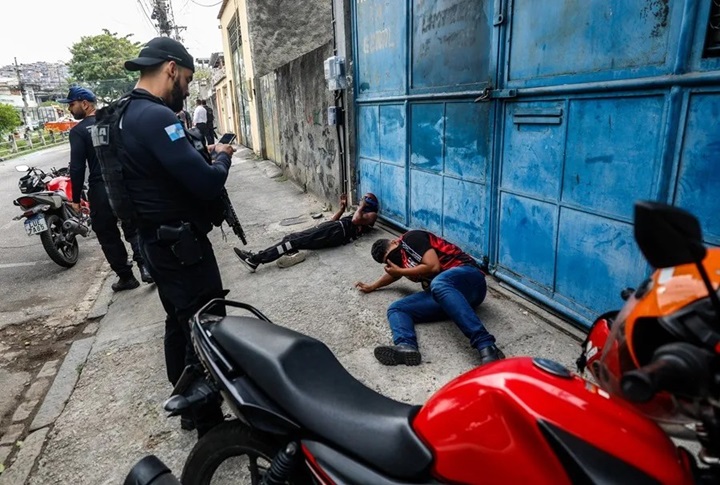Rio’s Long Night: Inside Brazil’s Deadliest Police Raid and a Favela Left to Bury Its Own

By dawn, the air over Rio de Janeiro’s Penha favela smelled of smoke, blood, and disbelief. Residents moved through the gray morning like ghosts, pulling bodies from alleys still slick with rain and gunfire residue. The state had come in the name of law and order. It left behind a line of corpses and a community that no longer expects help from anyone but itself.
A Line of Black Plastic at São Lucas Square
On Praça São Lucas, just outside a public day-care center, the bodies lay in a row—dozens of black-plastic shrouds baking under the early sun. Mothers, grandfathers, and teenagers pressed forward, whispering names. Some lifted the sheets with trembling hands; others stood motionless, staring as if sight alone could rewrite what they saw.
Through the night, while shooting echoed through the hills, neighbors fanned out to search for the missing. “The state abandoned us a long time ago, and they abandoned us again after this massacre,” said Rayune Diaz Ferreira, thirty-six, who had not slept while looking for her cousin. “The people carrying the bodies are the residents,” she told EFE, her voice hoarse from exhaustion.
The operation had sent 2,500 police officers into Penha to capture alleged leaders of the Red Command (Comando Vermelho), Rio’s oldest criminal faction. When it ended, the official version spoke of success. But on the ground, success looked like 50 bodies on asphalt and a neighborhood asking the same question it asks after every raid: when will security mean protection, not invasion?
Up the Hill, Volunteers Do the State’s Work
Far from the square, in the dense forest crowning Penha’s hillside, the living began the grimmest labor. About twenty residents—primarily women—formed a rescue line. With a single stretcher between them, they hiked muddy trails scattered with shell casings, torn shirts, and blood. Each recovery took hours. The stretcher bearers inched downhill, four at a time, toward a waiting van.
When the driver returned to São Lucas with the latest victims, someone always whispered: “There are more just ahead.”
Lawyer Thais Loredo, with the human-rights group Instituto Anjos da Liberdade, accompanied the volunteers and told EFE that some corpses showed signs of torture. The claim sent grief curdling into anger. With no forensic teams and no official rescue crews, residents were doing the state’s work—preserving what dignity they could for the dead and, perhaps, evidence for the living.
From the hilltop, the city looked oblivious: planes descending toward the airport, the Atlantic glittering beyond. Down below, the favelas carried their own rhythm of tragedy—people hauling bodies on stretchers built for emergencies that never came.
Numbers, Doubts, and the Weight of Proof
Officials announced sixty-four deaths, four of them police. But by midweek, no one could say if that count included the bodies residents had retrieved. If the total stands, this was Rio’s deadliest police operation on record—an anti-gang mission that became a war inside a neighborhood of families and street vendors.
Police spokesmen spoke of “precision” and “results”: rifles seized, drugs confiscated, fugitives eliminated. Residents spoke of fear, chaos, and silence. Armored vehicles crushed through narrow streets; helicopters circled low enough to shake the rooftops; bursts of automatic fire lit the treeline that separates Penha from the neighboring Alemão complex.
“We have never seen anything like this,” Diaz Ferreira told EFE. “Never.” Her words hung like testimony, heavy with fatigue and disbelief.
Even basic facts—how many died, where, and how—remained uncertain. For Penha, uncertainty is not an academic problem; it is the void where rumor takes root, where mothers scour morgues because lists arrive late or never. Each missing name is another wound opened by the absence of answers.

EFE/ Antonio Lacerda
Regular Routes Reopen, Normal Life Does Not
By Wednesday morning, the city announced a return to order. Buses rolled again through the reopened roads; the army trucks withdrew. On paper, Rio was back to normal. In Penha, nothing was.
Shops around São Lucas stayed shuttered. The chatter of domino games, the smell of fried pastries from corner stalls, the thrum of stereo speakers—all gone. A single market reopened, its owner sweeping dust from a doorway that still smelled of gunpowder.
People tried to resume what life demanded: jobs, school runs, and finding bread. But the map of safety had been redrawn overnight. Streets that were shortcuts yesterday are avoided now. Alleys carry ghosts. Conversations shrink to whispers when uniforms appear.
Penha and its twin hill, Alemão, have long balanced between two sovereignties—the traffickers who claim the territory and the state that invades it. The residents belong to neither. They build lives anyway: painting houses, raising children, opening shops. Every raid undoes a little of that work, scattering trust like debris.
Two unforgiving questions will judge this operation: Did it truly cripple the Red Command? And will the state account for the dead, as the residents have?
Also Read: Brazil’s War on Faith and Firepower: Inside Rio’s Deadliest Raid
Until then, the community continues the grim duty it began at sundown—carrying, counting, witnessing, and waiting for authorities to do the same.




